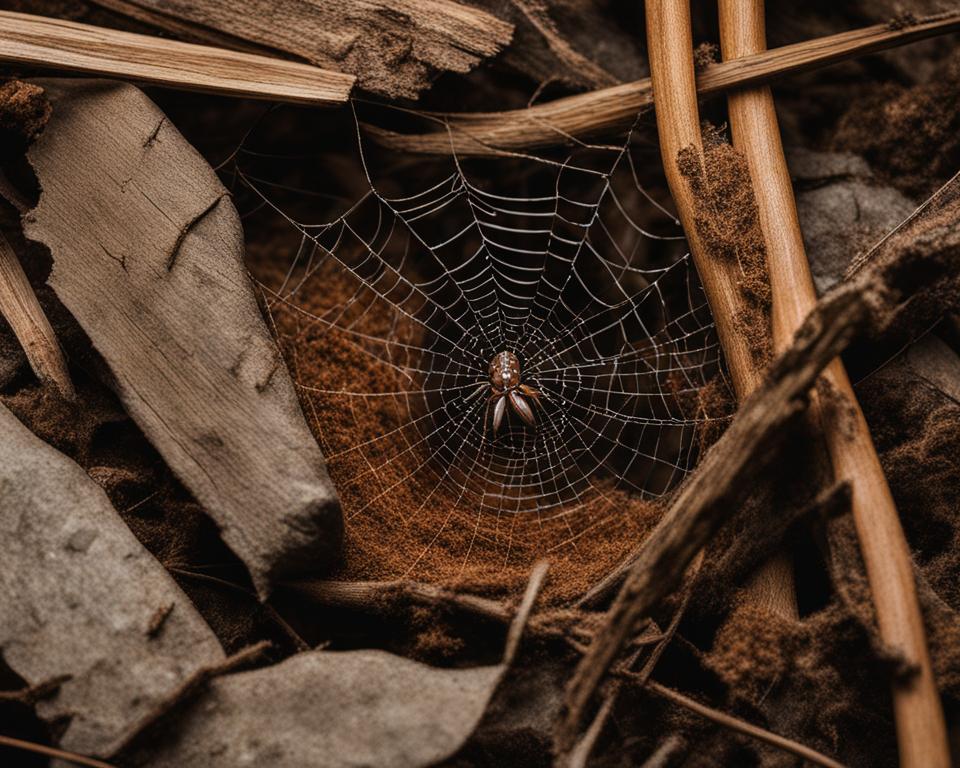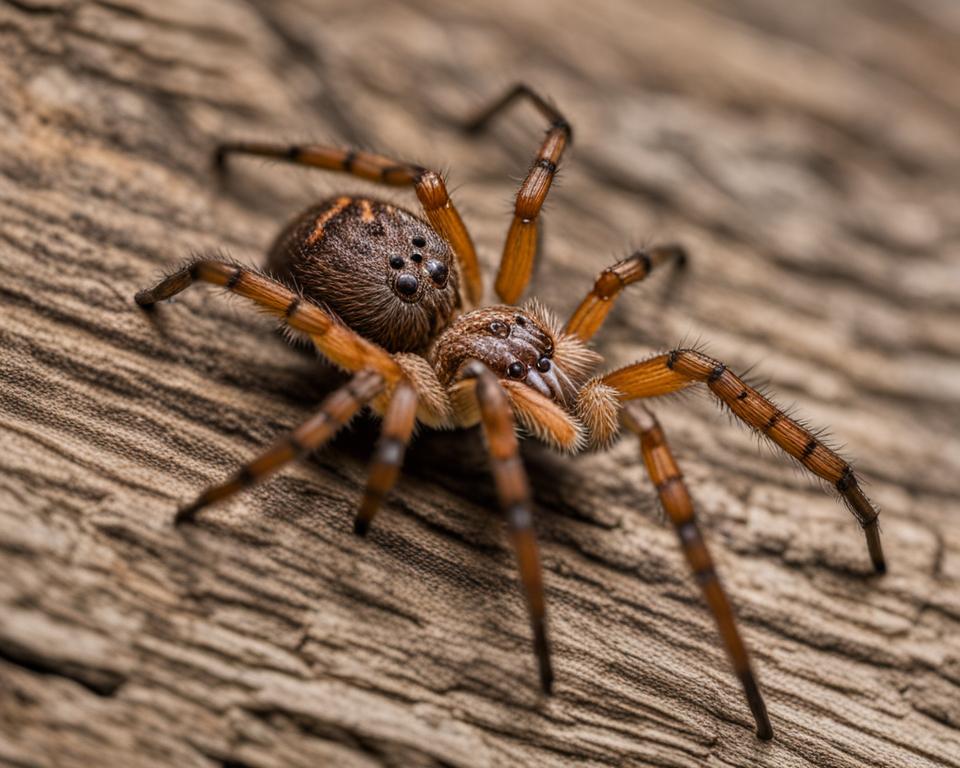When it comes to venomous spiders in the United States, two species that often come to mind are the hobo spider and brown recluse. While both are potentially dangerous, they differ in several ways that are important to understand. Knowing these differences can help you better identify them and know what to do in case of a bite.
Before we delve into identifying these spiders and their bite effects, let’s take a closer look at how they compare in terms of venomous spider classification and geographical distribution.
Key Takeaways:
- The hobo spider and brown recluse are two of the most dangerous spiders in the US.
- Understanding their differences can help with identification and response to bites.
- Both spiders possess venom that can cause symptoms varying in severity.
- Their habitats and geographic distributions differ.
- Being able to spot the physical characteristics of each spider is crucial when encountering them.
Identifying the Hobo Spider and the Brown Recluse
As venomous spiders, the hobo spider and the brown recluse have distinct physical features and identifying characteristics that set them apart from other spiders. Knowing how to differentiate between the two spiders is crucial for proper identification and medical treatment in the event of a bite.
Hobo Spider Facts
The hobo spider, also known as the aggressive house spider, is a relatively large spider, measuring up to one inch in length including their legs. They have distinct chevron-shaped markings on their abdomens and eight eyes arranged in two rows. Male hobo spiders have enlarged pedipalps, or sex organs, which are used during mating.
Hobo spiders are commonly found in the Pacific Northwest region of the United States, particularly in the states of Washington, Oregon, Idaho, and Montana. They prefer dark, moist environments and can be found in basements, crawl spaces, and around the foundation of buildings.
Brown Recluse Identification
The brown recluse spider, also known as the fiddleback spider, has a distinctive violin-shaped marking on its cephalothorax. They have six eyes arranged in pairs and can range in color from tan to dark brown. Adult brown recluse spiders are typically small, measuring ¼ to ½ inch in length.
Brown recluse spiders are native to the Southern and Midwestern regions of the United States, particularly in states such as Texas, Missouri, and Arkansas. They prefer warm, dry environments and can be found in dark, undisturbed areas such as closets, attics, and basements.

Hobo Spider Characteristics
In addition to their physical characteristics, hobo spiders exhibit certain behaviors that can aid in their identification. Hobo spiders are known for their aggressive behavior, particularly during mating season. They are also adept web builders, creating funnel-shaped webs that serve as their shelter and hunting ground.
Brown Recluse Behavior
Brown recluse spiders are known for their reclusive and non-aggressive behavior. They tend to be shy and will typically only bite if they feel threatened or provoked. Brown recluse spiders are also known for their ability to survive for long periods of time without food or water, making them resilient to changing environments.
Understanding the physical characteristics, habitats, and behaviors of hobo spiders and brown recluse spiders is essential for proper identification and prevention of bites. In the next section, we will examine the impact of hobo spider and brown recluse bites on humans.
Impact of Hobo Spider and Brown Recluse Bites
Both the hobo spider and brown recluse are considered venomous spiders with bites that can have serious health consequences. If you suspect you have been bitten by either of these spiders, it is important to seek medical attention immediately.
The symptoms of a hobo spider bite typically include redness, swelling, and pain. In some cases, the bite may develop into an open sore or blister. While hobo spider bites can be uncomfortable, they are not typically life-threatening.
The symptoms of a brown recluse bite may take longer to develop but can be more severe. The bite may initially go unnoticed, but over time, it may develop into a fever, chills, and nausea. In extreme cases, the bite may cause tissue death, leading to the need for surgical intervention.
If you are bitten by either spider, do not attempt to capture it for identification, as this can lead to further bites. Instead, try to remember or take a picture of the spider to show to a medical professional.
“Both the hobo spider and brown recluse are venomous spiders with bites that can have serious health consequences. Seek medical attention immediately if you suspect you have been bitten by either of these spiders.”
Differences in Bite Symptoms
When it comes to distinguishing between hobo spider and brown recluse bites, understanding the symptoms is crucial. Although both bites can cause discomfort and potentially serious health effects, there are some key differences that can aid in proper identification and treatment.
A hobo spider bite typically results in redness, swelling, and pain around the bite area. It may also cause itching, fatigue, and flu-like symptoms. In some cases, a blister may form at the site of the bite.
A brown recluse bite, on the other hand, often results in a mild stinging sensation followed by intense pain and itching. The bite area may develop a reddish-purple color and become swollen. As the tissue around the bite dies, a deep, open wound may develop. Other symptoms include fever, chills, and nausea.

If you suspect you have been bitten by a hobo spider or brown recluse, seek medical attention immediately. Proper identification of the spider and its associated bite symptoms can aid in treatment and prevent potential complications.
Habitats and Distribution
The hobo spider and the brown recluse have very different preferred habitats and geographic distributions in the United States. Understanding these factors can help you identify the spiders and take necessary precautions in different regions.
Hobo Spider Habitat
The hobo spider prefers to build its funnel webs in dark, dry environments such as basements, crawl spaces, and rock formations. In urban settings, they can also be found in buildings and spaces that mimic their natural habitats. Hobo spiders are most commonly found in the Pacific Northwest region of the United States, including Washington, Oregon, Idaho, and Montana.
Brown Recluse Habitat
The brown recluse, on the other hand, tends to inhabit warm, dry locations such as attics, closets, and woodpiles. They can be found in a broad area stretching from the central southern US to the Midwest. Brown recluses are often found in the following states: Texas, Oklahoma, Louisiana, Mississippi, Missouri, Arkansas, Kansas, Alabama, Tennessee, Kentucky, Indiana, Ohio, Georgia, Florida, and North and South Carolina.
It’s important to note that while both spiders have preferred habitats, they can also adapt to other environments in order to survive, making it possible to encounter them outside of their usual ranges.
Behaviors and Patterns
Both hobo spiders and brown recluses are known for their unique hunting techniques and web-building habits. While hobo spiders are primarily ground-dwellers and prefer to build their webs in cracks and crevices, brown recluses tend to build their webs in dark and secluded areas.
The hobo spider is known for its aggressive hunting style, often chasing and attacking prey rather than waiting for it to enter its web. In contrast, the brown recluse tends to lie in wait and ambush its prey when it gets close to its web.
When it comes to web-building, hobo spiders create funnel webs that are designed to trap their prey, while brown recluses build irregular webs that serve more for shelter than hunting. Hobo spider webs tend to be messy and disorganized, while brown recluse webs are usually neat and symmetrical.
Overall, understanding the behaviors and patterns of these venomous spiders is crucial for identifying them and taking appropriate precautions to avoid dangerous encounters.
Conclusion
Now that you have learned about the key differences between the hobo spider and the brown recluse, you can better identify these venomous spiders in your surroundings. Knowing their physical characteristics, habitats, behaviors, and bite symptoms can help you take necessary precautions to avoid potential bites and seek appropriate medical attention if needed.
Remember, both the hobo spider and the brown recluse can cause serious health complications if left untreated. If you suspect that you have been bitten by either spider, seek medical attention immediately. By staying informed and aware, you can help protect yourself and your loved ones from these dangerous spiders.
FAQ
What are the key differences between the hobo spider and the brown recluse?
While both spiders are venomous and found in the United States, there are notable differences between the hobo spider and the brown recluse. The hobo spider has a slightly larger size and more robust body, while the brown recluse is smaller and has a distinctive violin-shaped mark on its back. Additionally, the hobo spider is known for its aggressive behavior, while the brown recluse is more reclusive and avoids conflict.
How can I identify the hobo spider and the brown recluse?
The hobo spider is typically light to dark brown with a herringbone or chevron pattern on its abdomen. It has long legs and a stocky build. The brown recluse, on the other hand, is light to dark brown with a violin-shaped mark on its back. It has long, thin legs and a smaller body compared to the hobo spider.
What are the characteristics and habitat preferences of the hobo spider?
The hobo spider is known for its solid brown coloration, hairy legs, and funnel-shaped web. It is commonly found in the Pacific Northwest region of the United States and prefers dark, undisturbed areas like basements, crawl spaces, and outdoor vegetation.
How does the behavior of the brown recluse differ from that of the hobo spider?
While the hobo spider is known for its aggressiveness and tendency to bite when threatened, the brown recluse is much more shy and avoids interactions with humans. Brown recluses typically build irregular webs in dark, secluded areas and prefer to hide rather than confront potential threats.
What are the potential complications associated with hobo spider and brown recluse bites?
Both hobo spider and brown recluse bites can lead to various complications. These may include severe pain, necrotic wounds, skin ulceration, blistering, and in rare cases, systemic symptoms such as fever and fatigue. It is important to seek medical attention if you suspect you have been bitten by either spider to prevent further complications.
How can I differentiate between hobo spider and brown recluse bite symptoms?
Hobo spider bites typically result in a red, swollen area that may develop into a necrotic wound with a visible blister. Brown recluse bites often produce a reddened area that progresses to a blister and eventually forms a deep, ulcerated wound with a characteristic bullseye appearance. However, it is crucial to consult a healthcare professional for proper diagnosis.
Where are hobo spiders and brown recluses commonly found?
Hobo spiders are most commonly found in the Pacific Northwest region of the United States, including states such as Washington, Oregon, Idaho, and Montana. Brown recluses are typically found in the central and southern Midwest, as well as parts of the Southeastern United States.
